2025 TikTok Benchmarks
From TikTok engagement data to posting frequency and interactions analysis, these TikTok benchmarks offer insights into TikTok’s performance.
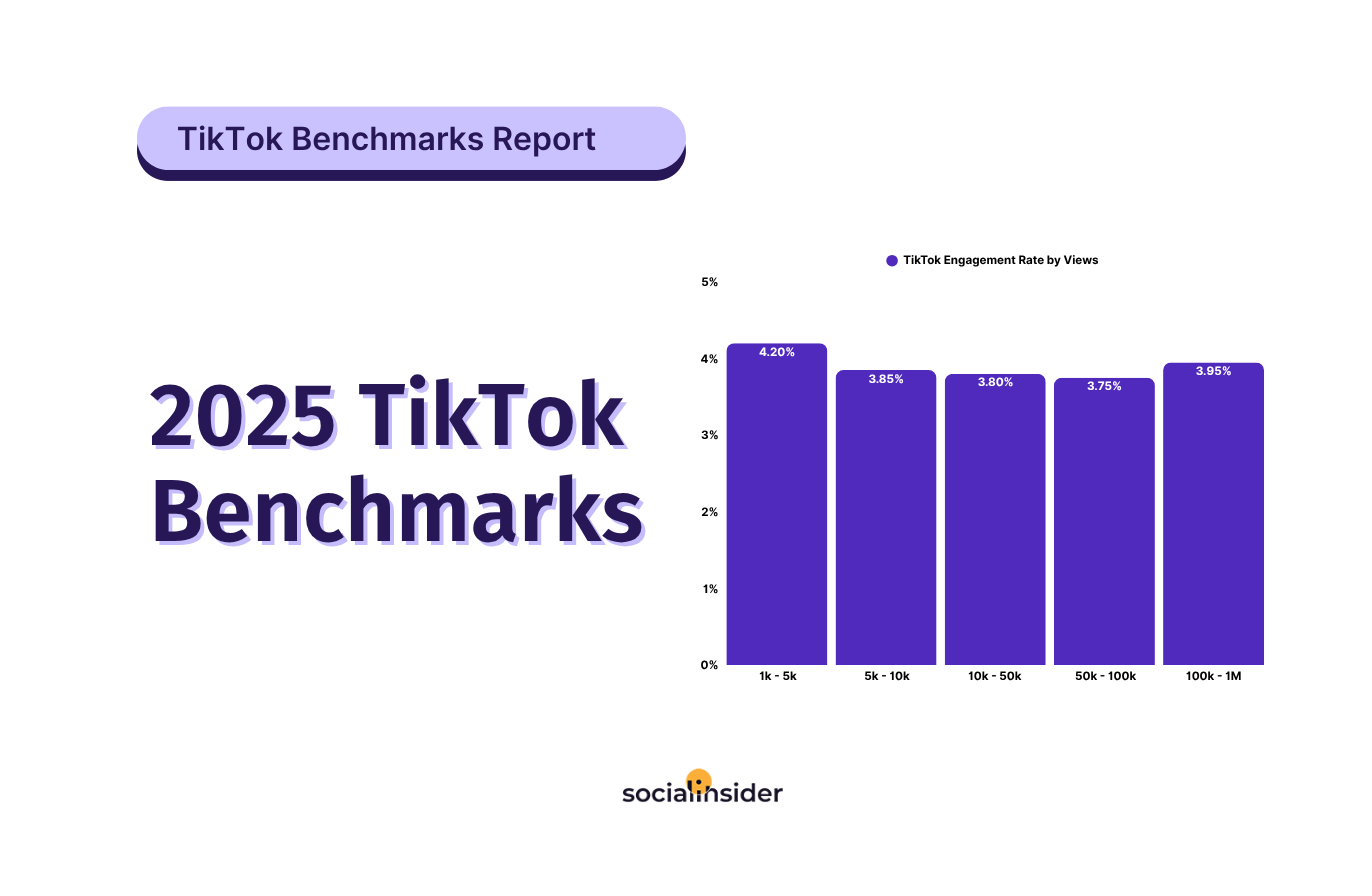
As TikTok moves into a more mature phase, the way brands perform on the platform is changing.
The era of rapid, unpredictable growth has given way to a more stable, but increasingly competitive environment. While TikTok still leads all platforms in engagement, success today depends on more than just showing up. Content quality, consistency, and audience understanding play a bigger role than ever.
In this report, we’ve analyzed performance across business accounts of all sizes to understand how metrics shift as brands grow. From smaller pages building tight communities to large accounts scaling reach and visibility, this data offers a clear view of what performance looks like right now—and what’s possible.
Whether you’re benchmarking your current results or planning for the year ahead, this study is designed to give you a realistic, data-driven perspective on what’s working on TikTok in 2025.
Executive summary
- In the first half of 2025, TikTok scored a 12% increase in engagement, reaching an average of 4.90% engagement rate.
- The smallest TikTok accounts (those below 5K followers) score the highest engagement rate by views, which is 4.20% on average.
- The largest TikTok accounts (those with more than 100K followers) get the highest number of likes, comments, shares, and views.
- Smaller brands tend to use TikTok carousels more often than larger accounts, with 3% of their posted content being carousels compared to just 1% for the largest accounts.
- The biggest brands are the most active on TikTok, posting an average of 15 posts per month, compared to the smallest accounts, which post an average of six posts per month.
- While the largest accounts see an average YoY follower increase of 33%, the smallest TikTok accounts achieve an impressive 269% growth in followers YoY.
2025 TikTok engagement trendline
While TikTok's engagement remained relatively stable in 2024, with only slight increases toward the end of the year, the first half of 2025 marked a significant jump.
Engagement began at 4.36% in January 2025 and climbed steadily to 4.90% by June 2025. Compared to the same period in 2024, when rates averaged around 3.85%, TikTok’s performance has improved and thus indicating stronger audience resonance and sustained content relevance.
Overall, TikTok continues to cement its position as the highest-engagement social platform, with momentum still trending upward mid-year.
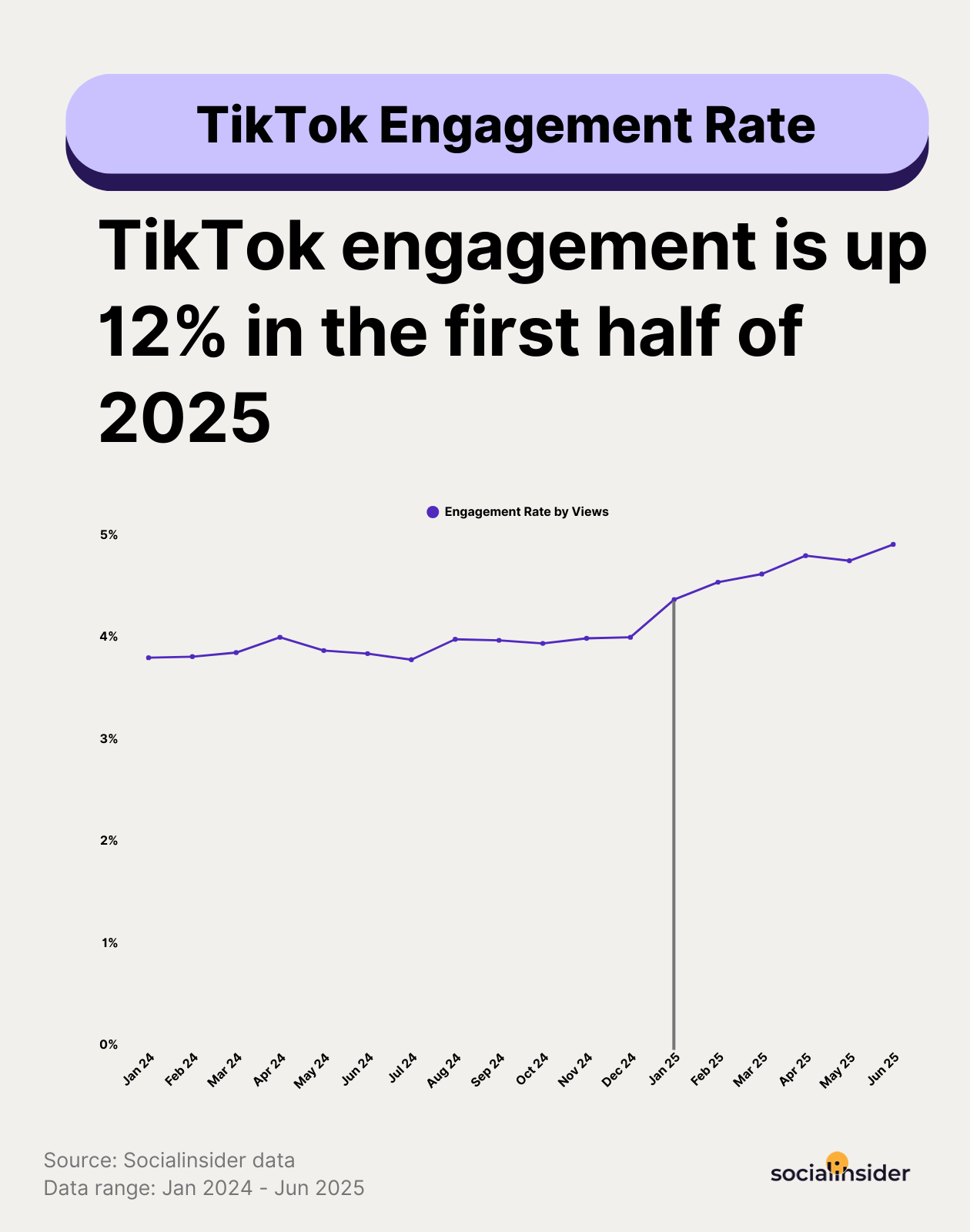
TikTok engagement benchmarks by views
TikTok closed 2024 with an average engagement rate by views of 3.85%, a number that stayed remarkably steady throughout the year, with month-to-month shifts staying within a narrow band, between 3.75% and 4.05%.
So, what does this mean?
TikTok is entering a new phase of platform maturity. The explosive growth years are behind us. What we’re seeing now is a more stabilized content ecosystem, where success depends on quality, relevance, and alignment with user expectations, not just jumping on trends.
But despite its plateau in engagement, TikTok is still the best-performing platform out there. And the reason behind this? The people using it.
TikTok’s audience is largely made up of digital natives: users who are highly present, platform-literate, and deeply integrated into social media culture. They engage more frequently and with greater depth than the audiences on most other platforms.
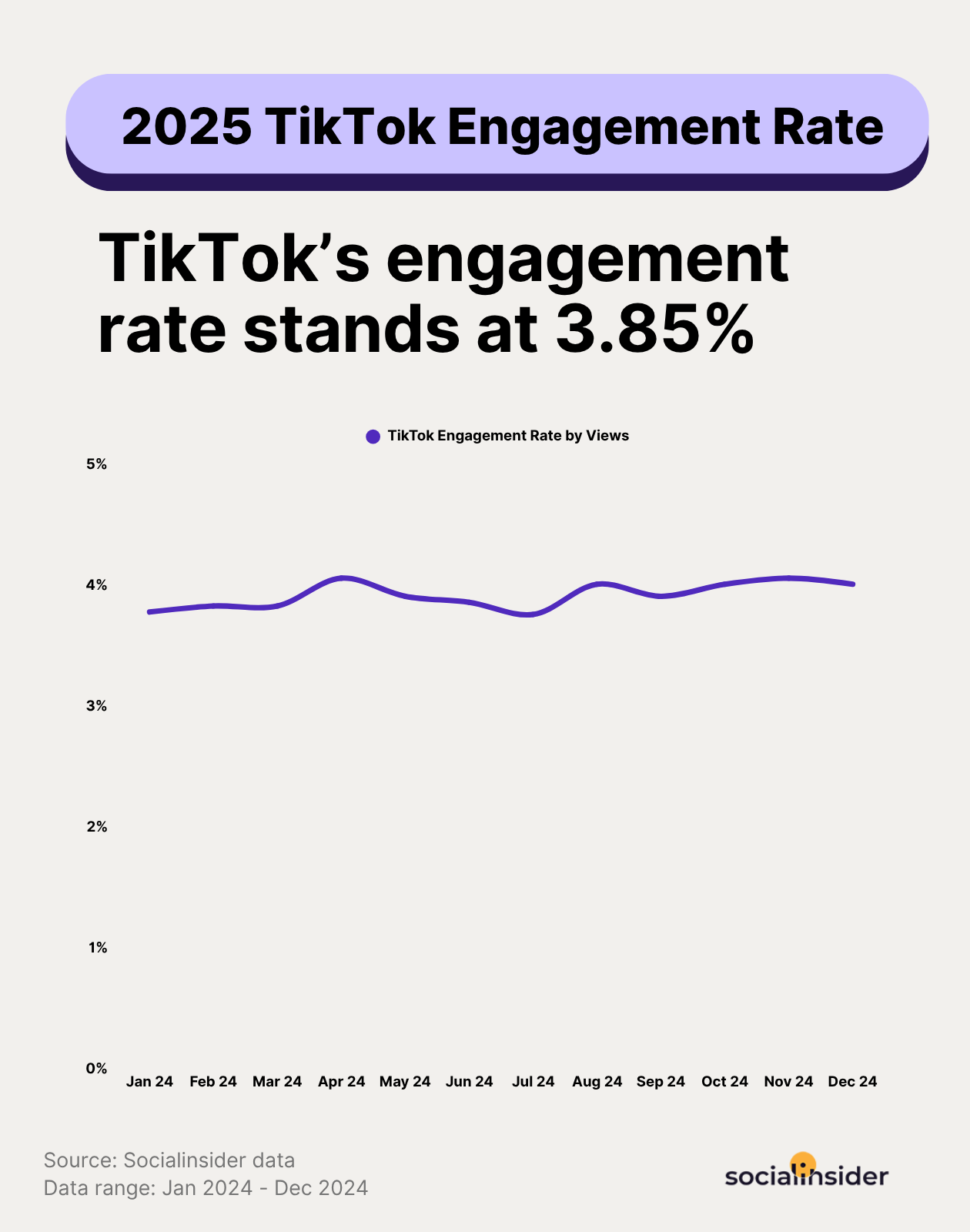
While we’ve established by now what a good TikTok engagement rate is nowadays, there’s something else you need to know. There’s more to TikTok engagement than a single benchmark. When we broke down engagement rates by account size, we’ve discovered that:
- Smaller accounts tend to generate more interaction per view. At this level, audiences are often more engaged, and the content feels more personal.
- Larger accounts still benefit from reach, but the content-to-engagement ratio is harder to maintain. As audiences scale, they become broader, and engagement starts to dilute.
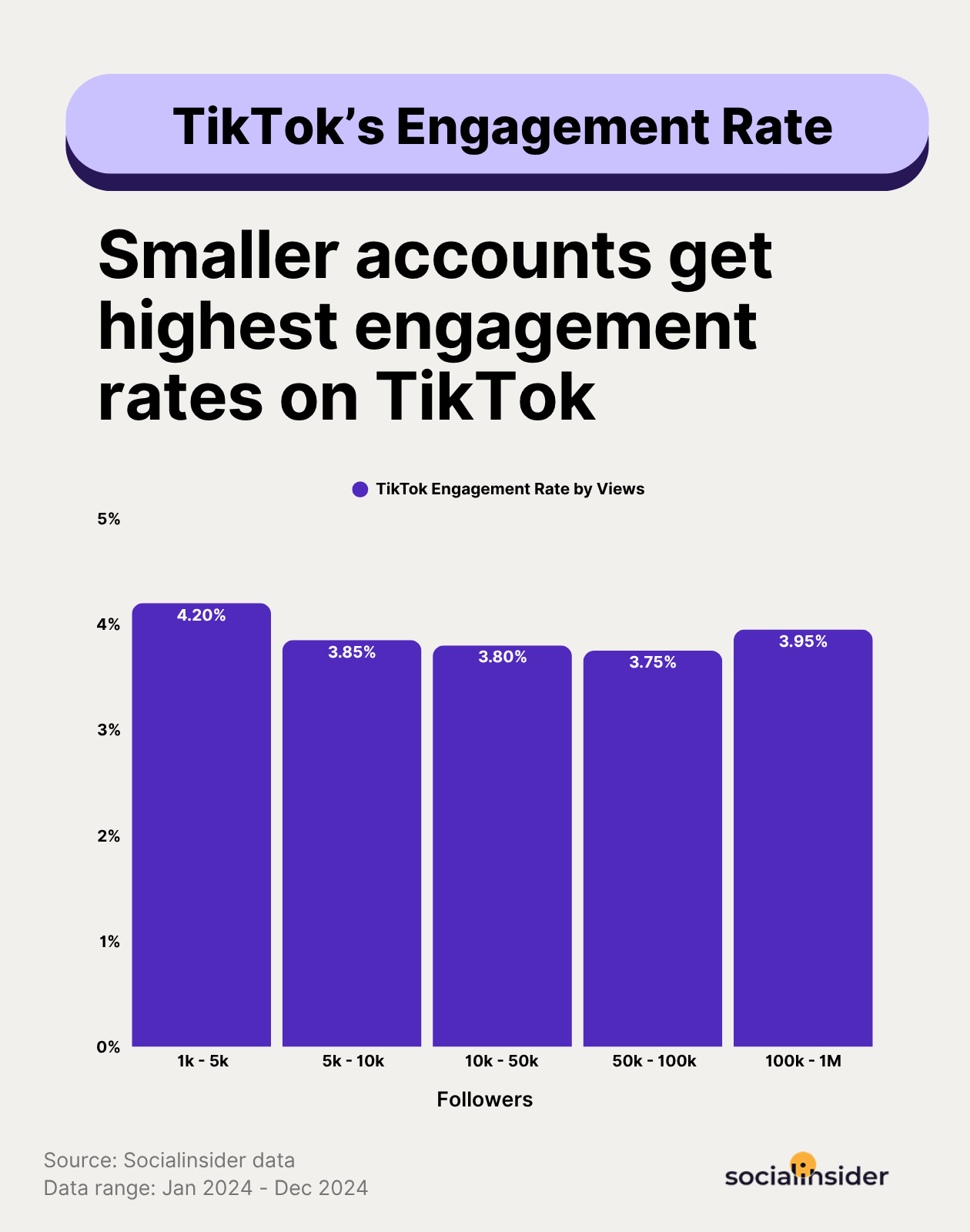
Strategic tactics to get a higher TikTok engagement rate
- Don’t chase virality—chase value: The age of one-hit wonders is fading. TikTok’s algorithm now rewards brands that deliver consistent, audience-first value. Focus on content that solves, inspires, or entertains—not just what trends. That shift alone can elevate your results above the average engagement rate on TikTok.
- Test, test, test: With engagement hovering in a tight range, simply posting isn’t enough. The brands outperforming the TikTok engagement rate benchmark are those testing new formats, playing with hooks, and remixing value-driven ideas into short, watchable stories. Show up with purpose.
- Hold attention, don’t just get clicks: The first three seconds still matter—but what happens after that matters more. The platform is increasingly rewarding content with higher retention, not just initial views. Best approach? Lead with a hook, but back it up with substance that makes people watch to the end.
- Leverage intimacy while you're small: If your account is under 10K followers, take advantage of the proximity you have to your audience. Engage in comments, reply with videos, and build community. This is where smaller brands can overperform the TikTok average engagement rate without spending on ads.
- Replicate small-scale behaviors at scale: Larger accounts can maintain high engagement by using formats that feel personal and human. Think behind-the-scenes footage, staff features, or casual, unpolished content. The more you replicate the feel of a micro account, the higher the odds you’ll break past the Tiktok engagement rate benchmark for your tier.
TikTok’s average likes per post
Beyond engagement rates, likes offer a quick pulse check on how your content is landing. And while it’s no surprise that larger accounts get more likes, the rate of increase isn’t directly proportional to the increase in followers.
As pages grow, they reach broader audiences, and that reach translates into more likes, but the jump is not always exceptional.
The biggest leap happens once a page passes the 100K mark, where the combination of scale, brand recognition, and algorithmic reach starts to pay off more visibly.
It’s also worth noting that follower count and likes go hand in hand when it comes to growth.
More visibility means more chances for content to land, and when posts consistently get higher like counts, they’re more likely to reach new audiences. In short, likes are a feedback loop that supports follower growth, especially for accounts already operating at scale.
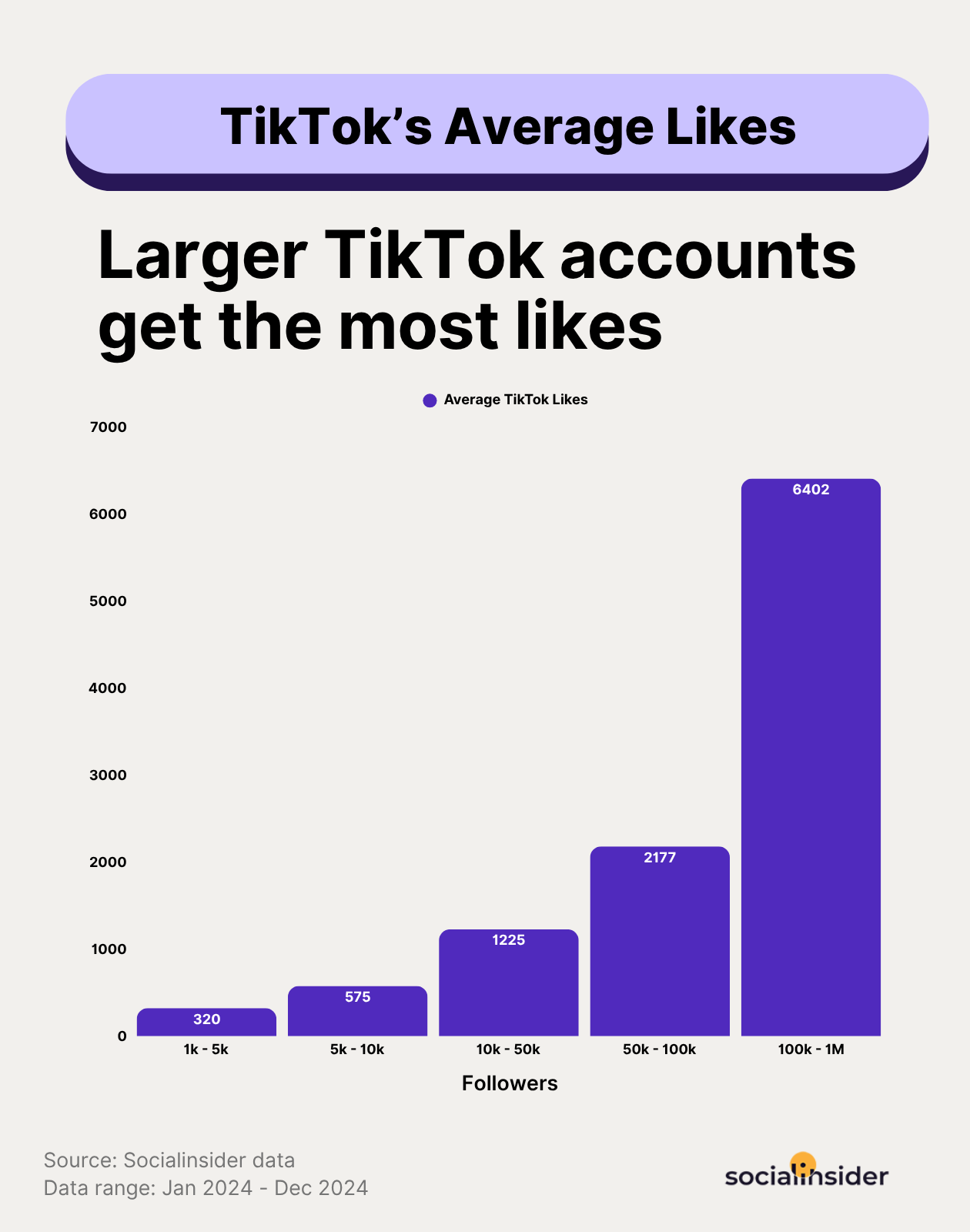
Strategic tactics to get a higher number of likes on TikTok
- Build like-worthy moments into your videos: Don’t just hope people like your content—give them a reason to. Humor, surprise, aesthetic satisfaction, useful tips—whatever matches your brand voice, deliver a moment people naturally want to respond to.
- Create for your current audience size: Small account? Stay niche. That’s what your audience followed you for. As your audience grows, start broadening your topics gradually to avoid losing engagement as you gain reach.
- Use like count to identify content that can scale: Posts that outperform your average like count are signals. Look at what worked, why it worked, and rework it into a repeatable format. This helps you turn occasional wins into a consistent strategy.
TikTok is not a place to be polished and uptight — it’s a place to be somewhat unhinged, have fun, and explore your creative boundaries as a brand. But you still need a strategy to keep it from becoming a hot mess. Strategy is your rail system. So step outside your brand comfort zone: lo-fi your core content, jump on trends, push your voice — just make sure it’s all heading somewhere. - Kseniia Volodina, Senior Social Media Manager at MY.GAMES
TikTok’s average comments per post
When it comes to engagement depth, comments carry more weight than likes. A like is quick. A comment takes effort. And based on 2024 data, the number of comments per post increases steadily as follower count grows.
What stands out?
Comments scale more consistently with page size. The growth curve is smooth, with each jump in follower bracket showing a meaningful rise in comment volume. What’s important here is that this type of engagement isn’t just about visibility; it reflects how compelling your content actually is.
People comment when something resonates, surprises, or invites a response. It’s the clearest indicator that you’ve made someone care enough to take a moment and share an opinion.
The data also suggests that larger accounts are better positioned to spark conversation at scale, likely due to broader distribution and more exposure to varying audience segments. But even smaller accounts can compete here if they’re intentional about how they structure content.
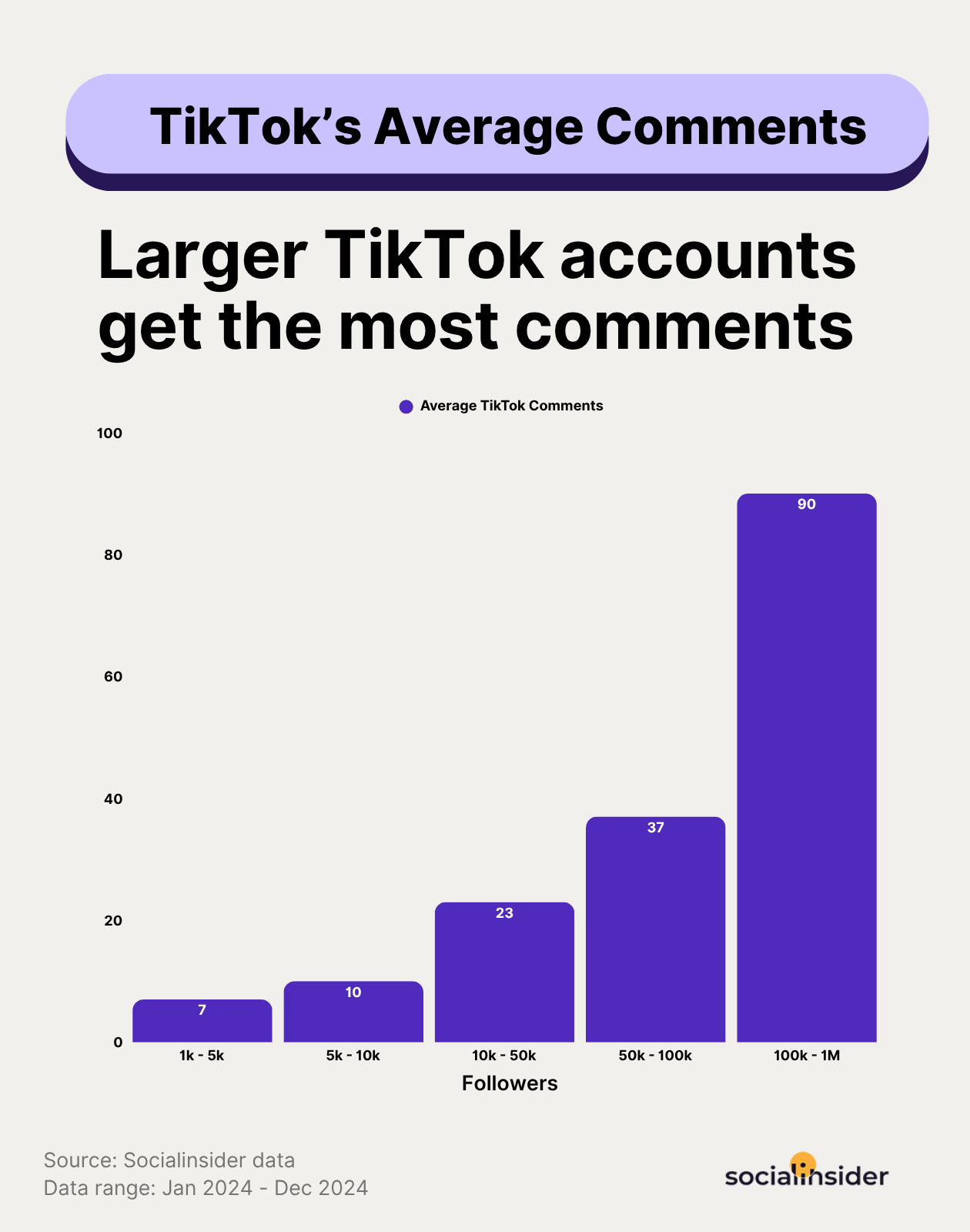
Strategic tactics to get a higher number of comments on TikTok
- Prompt interaction with intentional questions: If you want people to comment, give them something specific to respond to. Ask for opinions, preferences, or quick takes—whether in the video or the caption. “Which one would you choose?” or “Agree or not?” works better than a generic “Let us know what you think.”
- Create space for conversation, not just consumption: Instead of fully resolving every story or idea, leave something unsaid or invite interpretation. When viewers feel like they have something to add, they’re more likely to jump into the comments.
- Use your replies to drive more replies: Comments aren’t a one-and-done. When people engage, respond back, and not with generic emojis. Ask follow-ups. Pin good responses. Turn your comment section into an active thread that keeps pulling others in.
Success lives in the comments: smart brands are using them to test hooks, spark conversations, and plan their next post. Pinning witty replies, replying with videos, and turning reactions into content builds both loyalty and visibility. The brands that stay relevant are the ones jumping into cultural moments and showing up in the comments with personality and purpose. Don’t just post — interact like a real person. Malene Priebe Hold, Social Media Manager MCoBeauty
TikTok’s average shares per post
When a user shares a video, they’re not just engaging—they’re endorsing. On TikTok, shares play a major role in content distribution, helping posts break out of the initial view loop and hit wider audiences.
Larger accounts don’t just get more reach—they also have a stronger chance of creating content that gets shared. And shares matter. More than any other engagement type, they drive distribution. Shared videos get pushed further by the algorithm, fast-tracking exposure beyond a brand’s existing audience.
Once a page crosses the 10K mark, share volume starts to build—and past 100K followers, the growth becomes much more visible. At that point, visibility alone increases the chances that a video will hit different corners of the platform and land in new social circles.
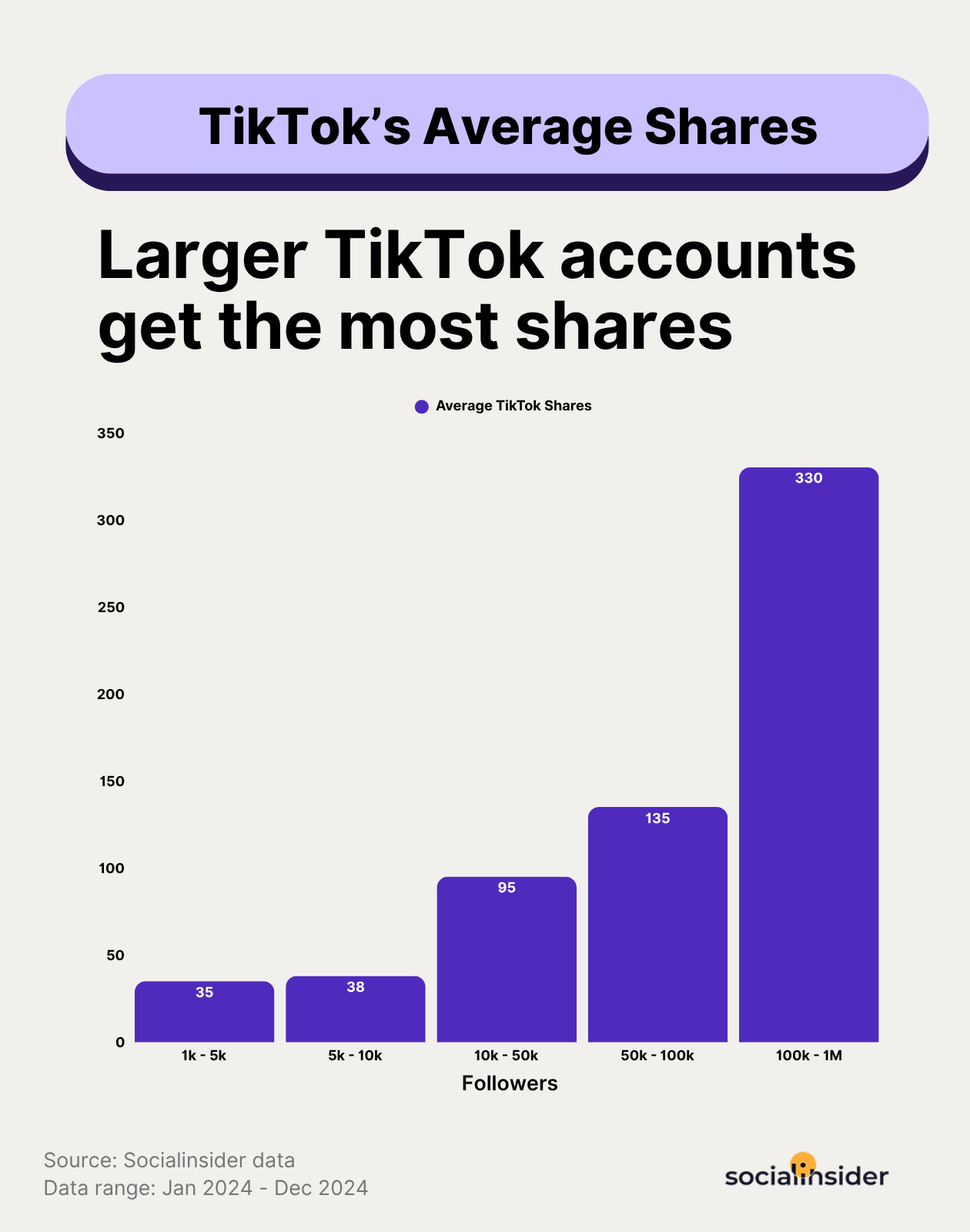
Strategic tactics to get more shares on TikTok
- Make shareability part of your content strategy: Think about what makes someone want to send a video to a friend. It might be helpful, funny, bold, or incredibly relatable—but it has to hit a nerve.
- Trend lightly, but add value: Riding a trend can earn views. Putting your own spin on it—especially one that adds insight, humor, or perspective—is what turns a view into a share.
- Build formats that are easy to return to: Series content and recurring formats make it easier to grow views over time. Familiarity drives rewatchability—and that’s a powerful metric TikTok considers when pushing content.
Brands can win on TikTok in 2025 by carving out a clear niche, not just in terms of audience, but in tone, format, and creative identity. The best-performing brands are showing up consistently in a way that feels native to the platform. Essentially, when you stop thinking like a brand and start thinking like a creator, that’s when TikTok starts working much better. - Sam Gillies, Chief Content Officer at Nonsensical at The TikTok Agency
TikTok’s average views per post
Out of all performance metrics, views are the starting point. They don’t just reflect how many people saw your content—they determine whether anything else can happen at all.
When looking at how views grow with account size, the pattern is clear: when switching from a following range category to another, the views number doubles, with the larger pages getting the greatest visibility.
This sharp jump in visibility, especially after the 100K mark, suggests that follower count isn’t just a vanity metric—it directly supports reach.

Strategic tactics to get more views on TikTok
- Front-load visual storytelling: TikTok’s audience decides in seconds whether to stay or scroll. Start with movement, contrast, or an unexpected visual to draw viewers in—especially important if your follower base is still growing.
- Place your brand or product naturally, not centrally: TikTok users don’t engage with obvious brand placement. But content that includes a product as part of a process, tutorial, or relatable moment sees better completion rates—and more views over time.
- Create content around search terms: TikTok is becoming a search engine. Use TikTok's search bar and auto-suggestions to identify popular queries in your niche. Build content around those terms to improve discoverability beyond the algorithm push.
You need a fresh approach to TikTok, one that isn’t afraid of testing new ideas and pushing the limits. Brands need to stop being brands and start being creators. This isn’t about following trends. It’s about rewriting who your brand is on social media and realizing that your competitors aren’t your competitors anymore. The whole internet and the people on it are your competition! So start making content that has drama, suspense, a great hook, and is entertaining. Chris Kubby, Social Media Consultant
TikTok posting frequency benchmarks
When it comes to how often brands post on TikTok, the trend is clear: the bigger the account, the more frequently they publish. Larger accounts publish significantly more videos per month compared to smaller ones, likely due to more resources, bigger teams, and a stronger push for reach.
But when we look at content type, another trend stands out: carousels still represent a very small portion of total TikTok posts, even as accounts grow. Most brands, regardless of size, continue to focus almost exclusively on video content.
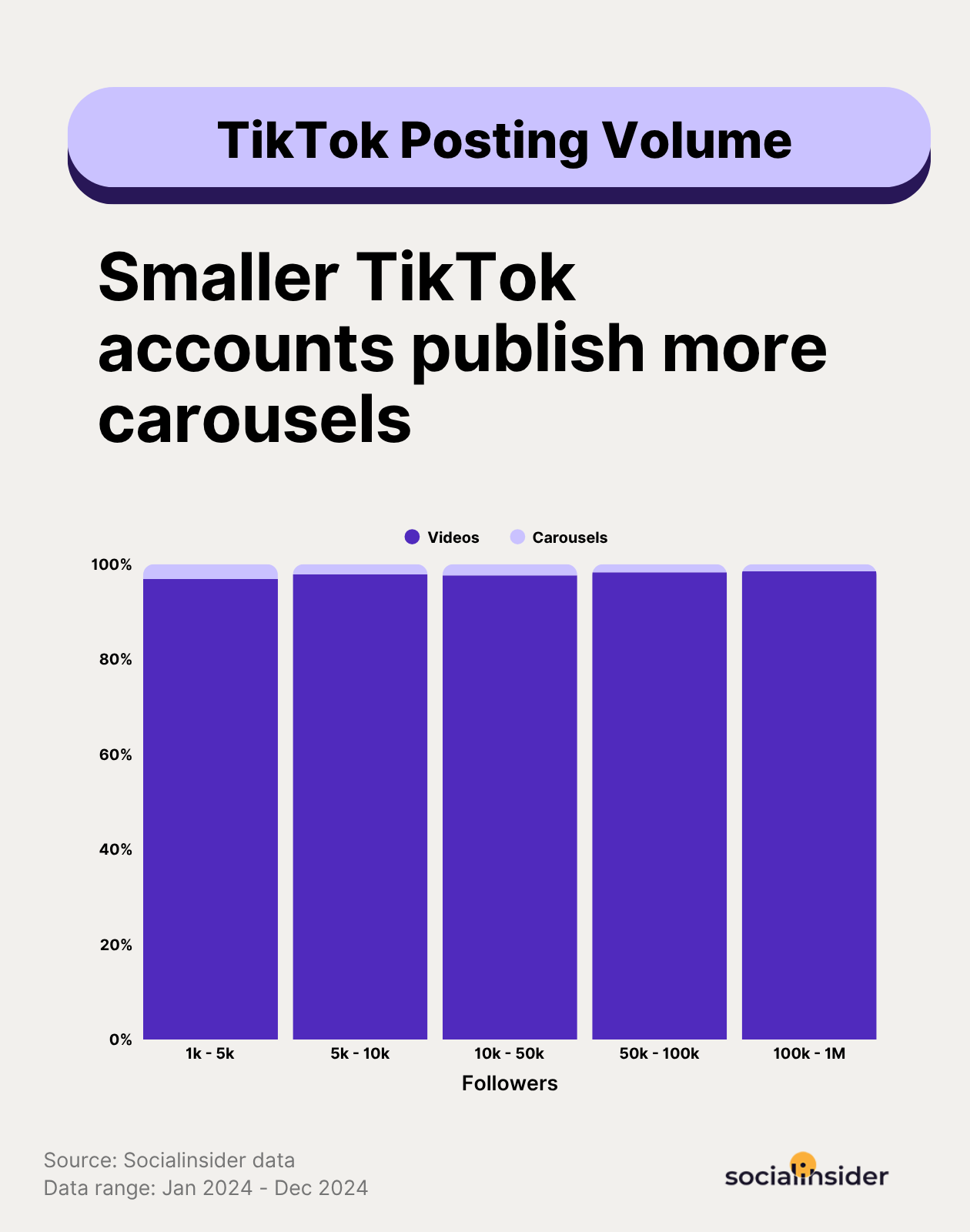
Here’s how carousels fit into the content mix by percentage:
- 1K–5K → 3.14% of posts
- 5K–10K → 2.17% of posts
- 10K–50K → 2.35% of posts
- 50K–100K → 1.71% of posts
- 100K–1M → 1.49% of posts
What does this mean?
While video remains the dominant format (over 96% of all posts), smaller accounts are slightly more likely to experiment with carousels. That might be due to lower production requirements - no need for editing or voiceovers - or because these brands are testing different ways to engage niche audiences.
Strategic tactics to improve your posting strategy
- Aim for consistency before scale: If you’re managing a small or mid-sized account, start by locking in a rhythm that’s sustainable, then build up.
- Don’t scale posting unless your content quality can hold: More content only works if it performs. If your engagement drops as you increase posting, pull back and optimize before ramping up again. Volume should never come at the cost of clarity or creativity.
- Use carousels strategically, not as filler: Carousel posts are still underused, which means less competition. Use them to break down tips, tell short stories, or share product-focused content that doesn’t require movement or voiceover.
TikTok follower’s growth rate benchmarks
When it comes to follower growth, smaller accounts are scaling at a much faster rate than larger ones. In fact, accounts under 5K followers scored an average TikTok follower growth rate that’s 8 times higher than the one of the accounts with over 100K followers.
The conclusion?
While large accounts still win in views, likes, comments, and shares, smaller brands are gaining ground faster. With fewer followers to begin with, every video has a bigger impact on overall growth. They’re also more agile, able to test formats and build close audience relationships.
On the other end, large accounts grow more slowly, but that’s not necessarily a problem. Their audiences are bigger, broader, and harder to shift dramatically. At that scale, growth becomes more about retention and reach than velocity.
Strategic tactics to boost your following on TikTok
- Use pinned videos to capture new audiences: Your top-performing videos or intro content should live at the top of your profile. These are often the first thing new viewers see—and they shape first impressions fast.
- Make your value obvious at a glance: New viewers decide quickly whether to follow. Your profile, video captions, and on-screen text should make it clear what kind of content you deliver—and why it’s worth sticking around.
- Align posting with cultural or seasonal moments: Tapping into larger conversations—holidays, trends, news, or shared experiences—helps expose your content to a wider audience beyond your current following. It also increases the likelihood of shares and saves, which are both tied to growth
Methodology
The dataset used to uncover these TikTok benchmarks consisted of 2M TikTok videos coming from 23.284 TikTok profiles that had an active presence on TikTok between January 2024 - December 2024.
TikTok engagement rate by views: it is calculated by adding the total interactions of Tiktok posts (including likes, comments, shares and saves) divided by the number of views gained within the selected timeframe and multiplied by 100.
Average likes per post represents the number of likes a post receives on average.
Average comments per post represents the number of comments a post receives, on average.
Average shares per post stands for the average number of shares a post receives, on average.
The average follower growth rate is calculated as the number of followers you gained divided by the number of followers you started with and multiplied by 100.
Analyze your competitors in seconds
Track & analyze your competitors and get top social media metrics and more!
Ready to improve your social media strategy with real-time insights?
Get strategic insights, analyze the social performance across all channels, compare metrics from different periods and download reports in seconds.